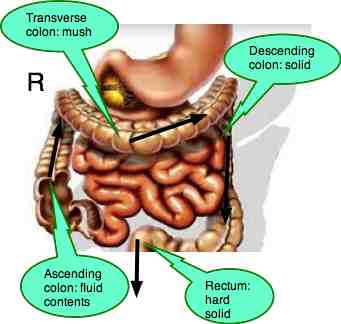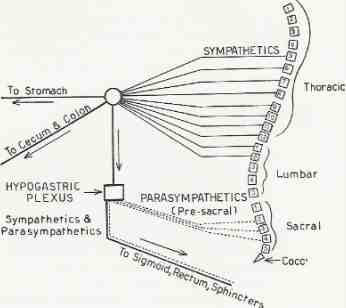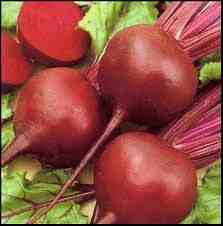Dear
Adult Potty Training
Greetings again from Chiropractic Help.
This month we consider the effect of constipation on both the ordinary citizen and those suffering from a slipped disc in the lower back.
A page on adult potty training may, at first sight, appear to be an odd topic on a chiropractic help website; however, constipation is a significant health problem in general. And, when associated with severe lower back and leg pain, is a very serious limiting factor to healing.
Unable to bear down due to pain with the so called Valsalva manoeuvre, even the patient with a healthy colon may develop difficulties when suffering from a slipped lumbar disc. For the constipated person it becomes a nightmare.
Normal anatomy of the colon
There are three main parts of the colon.
- Ascending colon: the contents are largely fluid.
- Transverse colon: mush becoming semi mush.
- Descending colon: becoming solid
By the time the contents of the colon reach the rectum they are normally quite hard. One of the main
functions of the colon is to reabsorbe water from the faeces so we do not become dehydrated.
Neatly set within this rectangle is the small intestine where most nutrient absorption occurs.
Muscles of the colon
There are two kinds of muscles in the colon.
- Circular muscles to promote mixing of the contents, keeping fresh material close to the wall of the colon where absorption of water and minerals occurs.
- Longitudinal muscles propel the fecal material towards to the anus.
Nerve supply
These muscles are activated by reflexes controlled by the autonomic nervous system and are largely independent of the conscious brain cortex; you are unable to initiate a bowel movement.
Stimulation of the parasympathetics located in the sacrum
initiates these movements. Thus, any injury to the lower back has the propensity to inhibit these reflexes, causing constipation.
During the defecation reflex, the parasympathetics initiate powerful contractions of the colon that are able to empty all the contents of the descending colon and rectum.
At the same time, another reflex initiates taking a deep breath, closing the glottis in the throat, and contraction of the abdominal muscles, helping to expel the faeces. This so called Valsalva manoeuvre also increases the pressure in the intervertebral disc causing intense pain if there is a herniated disc. Note those parasympathetic nerves coming from the sacrum in the graphic below.
The external anal sphincter is made up of voluntary muscles; it is under conscious control. We can stop the defecation reflex if the
moment is inconvenient, postponing defecation to a more suitable time. In effect, until the next defecation reflex.
In short, we can stop a bowel movement, but we cannot initiate it.
The role of fibre
Food contains two kinds of fibre:
- Insoluble fibre.
- Soluble fibre.
Both are important in maintaining a healthy colon.
* Insoluble fibre
The insoluble fibre gives bulk to the stool, helping to prevent "rabbit pellets." It has a laxative effect, facilitating the movement of faeces through the colon.
It is found in whole grains, but not refined white flour or white rice. Legumes like green beans and chickpeas are a rich source of insoluble fibre. So too, most vegetables and fruit have large amounts.
* Soluble fibre
This portion of the fibrous content of our food dissolves in the water in the bowel, forming a gel. It counters the laxative effect of insoluble fibre, slowing the emptying of the stomach, giving us a greater sense of being satiated; filled by the meal to satisfaction.
This slowing of the digestive process lowers the glycemic index of a meal; blood sugar does not rise as quickly and there is research showing that soluble fibre inhibits the absorption of the bad LDL cholesterol too.
Soluble fibre thus allows us to indulge occasionally in some otherwise taboo foods; white bread rolls and scones, white rice, potatoes, animal fat and a sweet dessert. A few squares of chocolate! After the meal!
Soluble fibre is found in oats, again in fruit and salads, nuts and
seeds.
- Quaker oats recipes
- Foods that lower cholesterol
Exercise
This is much research proving that general exercise promotes healthy movement of the bowel contents; since exercise usually involves pelvic movements, it stimulates the parasympathetics coming from the sacrum.
Walking, cycling, swimming... your choice; exercise is an important part of the maintenance of a healthy colon.
The inimitable beetroot
Beets are a rich source of both soluble and insoluble fibre; this wonder vegetable should be regularly on the menu of those suffering from constipation. Pressure cook them.
Adult potty
training
Our modern lifestyle prevails in virtually all of these areas against a healthy, happy colon.
- We are often unable to respond when nature initiates a defecation reflex. As a wise man said, "rush and hurry are not of the devil; they are the very devil." Carl Jung, I believe.
- The food industry has systematically removed the fibre from our foods, giving us a taste for white rolls and white rice, sugary foods like bagels and a dislike of foods like salads that are rich in fibre.
- Our work lives demand long hours in the motor car and in front of a computer; add to that the television and we've become the couch potato generation.
Positive steps to counter constipation
- If at all possible, when nature calls, respond. It may be a whole 24 hours before your autonomic system initiates the next defecation reflex; by then you'll have rabbit pellets. Remember, you can't initiate it; only
stopping the reflex is under conscious control.
- Keep a book in the toilet, relax and take the time for a complete bowel movement. Rushing off when you're only half done is a recipe for more troubles. A complete bowel movement empties everything in the descending colon and rectum.
- Make sure that all meals contain both soluble and insoluble fibre.
- Take a "Swedish stroll." The Swedes are known for talking a stroll around the town after dinner. Just a fifteen minute walk, daily, would profoundly improve not only the health of your colon, but your whole body. Your mind too; those who walk regularly suffer from less Alzheimers.
- If none of the above work, ask your chiropractor to examine your lower lumbar spine and the sacroiliac joints; there's anecdotal evidence that an adjustment too will help.
Meal plan
- Oats, nuts, seeds and prunes for breakfast. Eggs Florentine.
- A salad for
lunch; whole grain bread only. Low GI bread.
- Vegetables, including a legume, for dinner. Green bean and lentil soup.
Spondylotherapy
Whilst lying on the tum, and having someone gently pound repeatedly on the sacrum helps to stimulate the parasympathetics that will initiate the defecation reflex.
Bowel diseases
Take the health of your colon seriously. Neglecting this vital organ leads to very serious diseases. Recent research, following folk who ate on average eight coloured foods per day, found that they had 35% less all-causes of death.
Much of that benefit from coloured foods is that they are the very best source of both soluble and insoluble fibre.
Those suffering from the inflammatory bowel diseases that cause chronic diarrhoea should
- eat less of the insoluble fibre, and more soluble fibre. This sounds simple but
isn't as many foods contain both.
- make sure that the omega 6/ omega 3 ratio is low as possible. More omega-3 and less omega-6.
- avoid all grains with gluten.
Raising the omega 3 fatty acids in the diet has benefits for arthritic spines, inflamed muscles, blood vessels and the bowel.
- Anti inflammatory omega 3
Adult potty training
Have you allowed the health of your bowels to deteriorate? Take one of these recommendations, step at a time; adult potty training is a very necessary business in our society, and you are the only one who can do it for yourself.
Avoiding a stoma, and a cancer that metastasizes to the liver is the motivation; it doesn't only happen to other people.
As the Dutch say, "those who won't hear, must feel."
Retirement sentiments
If you read this column with any regularity, you'll know that I write from the perspective of where I am today. Today it strikes me that I am officially over the hill; retired. But I'm happy to report that I've never been busier or more fulfilled; this morning I'm up a 4am finishing your Chiropractic Help newsletter, a few patients before venturing out to the soaring club for a day in the air, hopefully flying at 10,000 feet, all without an engine.
I've done a good deal of thinking about this retirement business; Malcolm Forbes once said that it kills a lot more people that hard work ever did. Quite so. It's vital to retire into something that captures your heart and energy, otherwise you'll move very quickly from living in the sunshine to the shade, to quote Don Hewitt, director of 60 Minutes for thirty-six years. He retired at eighty-one.
And the best from the incomparable Margaret Meade:
"Sooner or
later I'm going to die, but I'm not going to retire."

Kindle
I, as a writer, was encouraged on a recent trip to see how many folk were reading on Kindles. You can store 3000 books onto one small device, all instantly available. Keep one in your toilet for your adult potty training!
Seriously though, books are not going to die fast, but there are more ebooks being sold than in paper; they used to be a lot cheaper, but that's no longer necessarily true. There's a real convenience being able to store all your current books on one small Kindle; the "paperlight" is the best.
You can read Frog in my Throat and Bats in my Belfry in paperback, but Stones in my Clog is only available as an ebook; at about $4, it's half the price of Frog and Bats.
Stones is about my seven glorious years working as a chiropractor in Holland; enjoy. You can find them at Bernard-Preston.com.
Abdominal Hollow
There is considerable interest in a very simple exercise called an Abdominal Hollow that can be used to strengthen your core muscles and reduce the incidence of lower back pain.
It can be done either on its own, or incorporated in the pelvic tilt and the Cat and Camel yoga exercise of old.
Lying flat on your back with the knees and hips at ninety degrees, simply pull in the stomach and breathe out simultaneously to raise the diaphragm. Repeat fairly quickly, say, ten times then hold for a half minute or so. You can do it sitting too.
Then go straight into the pelvic tilt by raising the buttocks slightly off the table, then lowering the pelvis and finally gently arching the back.
The Cat and Camel does essentially the same, but whilst kneeling on all fours.
Check out the lower back exercises page at Chiropractic Help; I do these myself every day. They are essential for those who want to be able to dig
in the garden, enjoy activities like lifting beehives and gliders, and generally have a dislike of lower back pain. Two or three minutes a day will make an enormous difference to your lower back. Do them!
Till next month, then... yours in better health.
Barrie Lewis DC and Bernard Preston DC!
PS. Feel free to forward this to family and friends, your chiropractor and even your medical doctor! You can support this site by purchasing one of Bernard Preston's chiropractic books. Dirt cheap on you Kindle, tablet or smartphone.
CHIROPRACTIC HELP Backissues of our newsletters.




